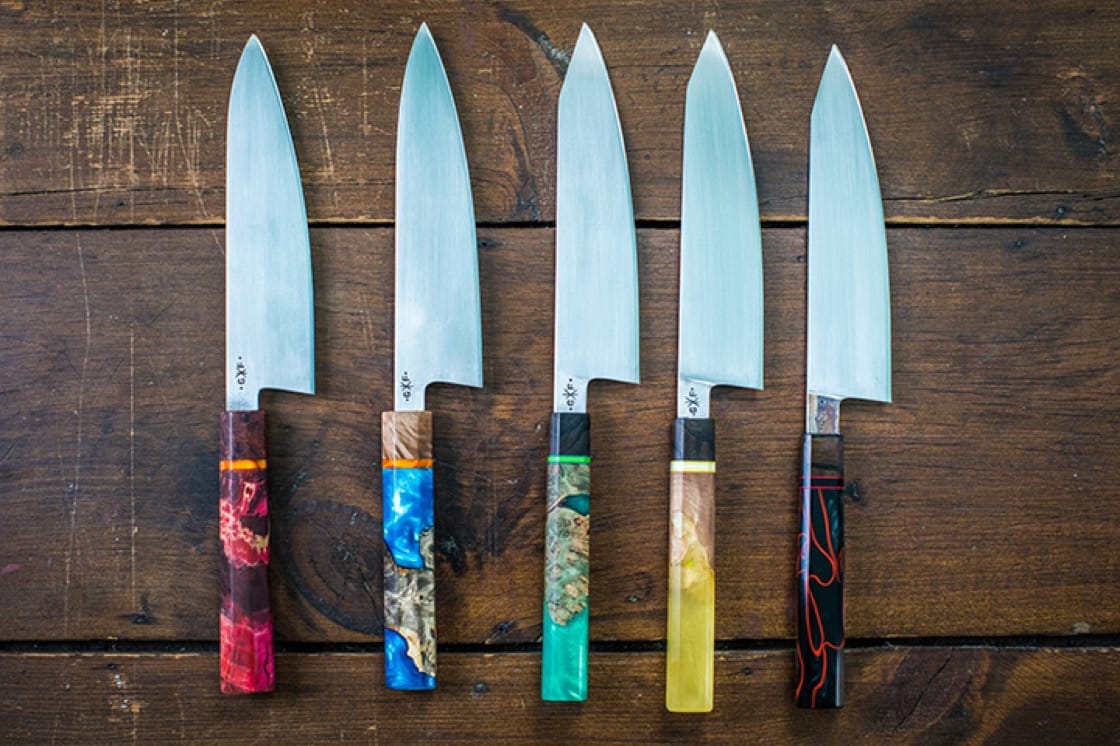Of all the kitchen equipment you'll ever own, nothing is more vital or more indispensable than a good knife. This is particularly true of a chef's knife, which thanks to its design is suitable for a broad range of tasks, from chopping vegetables to slicing fish, and breaking down chickens to mincing garlic or ginger.
We asked three experts to weigh in on what qualities to look for in a chef's knife—Mareko Maumasi, a bladesmith specializing in custom-forged, multi-thousand-dollar damascus knives whose waitlist is three years long; Geoff Feder, a blacksmith and knife maker who has crafted blades for celebrity chefs like Charlie Palmer and Bryan Voltaggio; and Tim Mussig, CEO of JB Prince, one of New York's most esteemed purveyors of chef tools and kitchen equipment.

Go With What You Know
According to all three experts, one of the most basic starting points is simply to pick what you're familiar with and what feels comfortable.
"It can be very overwhelming getting your hands on every single eight-inch chef's knife in the [store]," says Maumasi. "If you already have an idea of what you're familiar with, that kind of informs you on where to start and what kind of [size] range to work in." Feder adds, "[People] like the kind of knife they are the most used to."

Size Matters
Chef's knives come in a wide variety of sizes, from a diminutive six inches all the way up to a whopping foot long and beyond (which can look more like a short sword than something used for cooking).
"As a general rule, the first place we point people is an eight-inch chef's knife," says Mussig. "[That's] a very, very good place to start for a home cook, simply because it gives you enough blade to handle all of the tasks you need to do in your kitchen."
European vs. Japanese
Whereas European-style chef's knives are designed for a wide range of tasks, Mussig says, "Japanese knives are historically more task specific." Various tasks such as cutting noodles, slicing fish, or chopping vegetables greatly influences how the knife is designed.
According to Maumasi, European-style knives have a "more robust geometry," including a bolster which extends from the blade to the handle. They'll be a better fit if you like to use a rocking motion to chop or mince. Feder says another difference is how the edges of the knives are ground. Japanese knives have a much more acute angle on the cutting edge, which makes them more suitable for tasks like slicing or chopping up and down as opposed to rocking, but they can also be harder to sharpen and care for.

"The Business End"
According to Maumasi, the handle of a knife is one of the most important components to consider. "This is the business end," he says. "This is where you actually have the relationship." If the knife doesn't feel good in your hand and if it doesn't match your grip, you're not going to enjoy using it. This is particularly true if you use a pinch-grip, which can dramatically influence which part of the handle actually ends up in your palm.

Handle With Care
Lastly, Mussig, Maumasi and Feder are quick to point out that stainless steel doesn't mean stain-proof. Another option is carbon steel, which retains a sharper edge but naturally discolors and—if left wet or exposed to significant humidity—rusts. Stainless steel doesn't have these issues, but it's not indestructible. Knives should always be washed by hand—NEVER put them in a dishwasher, even if the manufacturer explicitly says you can. Detergent is both caustic and abrasive, and can destroy a knife.
The experts also recommend storing knives so that they don't touch each other or other metal objects, which can damage the blade. (A wooden knife block is a good option for this.) Also, make sure you use either a food-safe plastic or wood cutting board. Maumasi believes that cutting boards made from glass, stone, or ceramic are really "trivets in disguise" and will do serious damage to your cutting edge. "I always recommend natural wood if possible, then standard NSF plastic cutting boards or dense rubber boards like the ones commonly used by sushi chefs."









